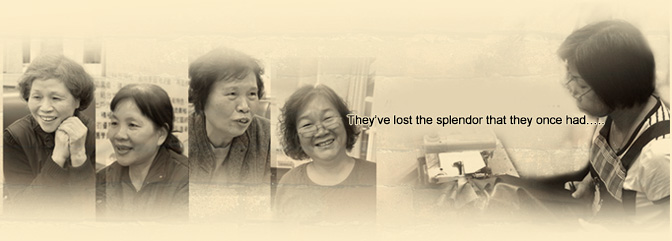Survey background
From interviews and documents, we learned that Sanchung area used to be the most prosperous place of textile industry. The original development areas in the west and north were adjacent to Luzhou, which developed fast in textile industry. However, the once prosperous small garment factories and sewing workshops, with the relocation of factories and withering of industries, are nowhere to find.
Firstly, we asked our team members to search for and record the data regarding textile and garment industries of Sanchung and Luzhou areas online. Then, we asked all students of the school to search for any possible clues around. We even searched and visited home by home against the data on Yellowpage. Finally, we found our interview targets, drafted interview questions, and conducted interviews.
After discussion and actual visit, we found 2 sewing workshops willing to participate in our interview. We are anxious to know, through field survey, why they choose to operate in lanes and alleys, the comparison of the past prosperity and the current situation, how the industry faces the future development. Further, we hope to introduce the industrial development to the students and residents for their knowledge. |
| Our thoughts: | |
Po-ta Chen |
which is not only an experience, but also the answer to the senior students; moreover, it is the responsibility to be a member of Lu Chiang Elementary School, and the mission to guard the history of Luzhou. Our main aim was to explore the Peiguan Music. My previous concern was the option between the Peiguan Music or Lele Music. However, after I viewed the theme of Zhouhou Village produced by my senior fellow students, I clearly knew the way to reflect and how to display the emphasis. The senior fellow students vividly described everything about Zhouhou Village, the villagers of Zhouhou Village were forced to relocate their simple and memorial hometown, and the Zhouhou Village was famous for its taro and oranges in Taipei, which was interesting and vivid. However, the prosperous history has been lost silently and forgotten by the world, which was heart-aching. I also viewed the theme for God culture produced by the senior fellow students, which was interesting in content. However, the graphs were far from enough. If more images and clips were produced, the content would be richer. Comparably speaking, the theme about Zhouhou Village was better, more detailed and brilliant. I will work harder and never let my teacher down. Garment factory was memorial to many people of elder generation. For some reasons, the garment factories in Taiwan either shut down or relocated to countries where labor cost was low. My mom used to work in some garment factories, but she only worked for less than 3 months. She said that the first-month salary was TWD 10,000.00 and TWD 5000.00 for the next two months. In consideration of the low wage and labor consuming, she decided to work as an accountant that was high in salary and labor saving. I have an aunt sewing clothes at home. I think she does this job to make a living.
|
Yi-ping Liu |
The garment industry in Taiwan has been relocated to Chinese Mainland, Vietnam and other places in recent over 10 years. The garment manufacturing process is bitter, and there are a decreasing number of young generations that is willing to learn. The garment factory in Taiwan is withering. Although the Taiwan government has signed ECFA with the central government, the inheritance of garment industry has been neglected, the prospect of garment industry is bleak, and therefore, the government is advised to pay more attention. If the cloth material suppliers could be motivated to set up delicate and special garment production line, improve VAT of products, create brand marketing market, cooperate with designers and small and medium-sized garment manufacturers, and develop co-owned brads and fashionable textile products, perhaps the garment manufacturers in Taiwan might find another opportunity of development.
|
Jin-yu Chen |
Reasons why textile industry develops fast in Taiwan: Since the retrocession of Taiwan, its textile industry has developed for over 50 years. At the initial period of retrocession, Taiwan government sent personnel to be in direct charge of coordination and planning. However, the proportion of garment export out of the entire textile products decreases gradually in recent years, from 60% in 1985 to 15% for the 11 months in recent years. The family-operated garment factories were on the verge of shut down, while they went to South East Asia and Chinese Mainland to try their chance, the depression of garment industry occurred, yet we were unaware of it.
|
Bao-le Chen |
The garment industry, reported to be the twilight industry, have been closed down and relocated. The textile and garment industry that stimulated the growth of Taiwan economy has experienced reform and transformation of over 50 years. Each stage of textile and garment industry is the background of Taiwan economy. The garment manufacturers have constructed the structure pattern of garment production in terms of production and sales channels. Although there is automatic reform in science and technology, the “labor expenditure” is a must. The important place of textile and garment manufacturing used to be in Japan and Taiwan, however, due to increasing labor cost and appreciation of TWD, the competitiveness of textile industry is at a remarkably disadvantage compared with before. The Taiwan government stirred that the computer and semi-conductor industry replaced textile industry. The garment industry is labeled as “twilight industry”. The majority of manufacturers either relocated or closed down. The garment industry withers so significantly that its turnover is less than 1/6 compared with before. Therefore, is it the trend, sole orientation of the industry or is the garment industry the deadlock for talents?
|
The garment industry is labor intensive. The production cost of garment industry increases, the demand has shifted to emerging market. In order to respond to such changes, the garment enterprises in Taiwan not only have to increase the diversity of clients, but also relocate production facilities to such other places as Philippine, Indonesia, Thailand, Vietnam of South East Asia, Chinese Mainland, or Mexico, Salvador and Nicaragua in Central and South America. Therefore, domestic production capacity gradually withers from the kingdom of textile garment to be replaced. Living in the place famous for garment production, I hardly recall. This activity reminds me that there are so many hard-working tailors around us, making delicate and beautiful garments and creating reputation for Taiwan. We hope that what has taken place on this land will be seen by more people.
|
|
Ya-guan Wang |
The garment industry is the earliest link of textile industry in Taiwan to enter globalized layout. However, due to change of economic environment in Taiwan and worldwide, rising of garment industry in low-wage countries and South East Asian countries, as well as the impact of free trade and globalization, the international garment market intensifies, and the garment industry in Taiwan needs an investment environment of lower cost. Therefore, the garment industry in Taiwan is confronted with grave opportunity and most threats. Also confronted with such impact include the sewing workshops under the theme this time. It is worth deliberating as to how to help the small processing factories to survive under the impact of globalization.
|
An-peng Wu |
The garment industry in Taiwan is mainly export oriented, and has been predominated in the textile products until major changes took place in 1987. The reason for such change is undoubtedly appreciation of TWD, rising wages, shortage of labor and bubble in the economy, the production cost of garment increases, so does the competition of cheap labor in adjacent countries. On the other hand, the free trade agreement of USA to implement regional economy attracts manufacturers to invest and set up factories. As a result, many garment factories in Taiwan select to set up production bases overseas in order to enjoy the trade preference, lower the production cost and pressure as well as the prolonging the life of the industry. Nevertheless, there are still many garment industries and the downstream factories left in Taiwan. The Luzhou I live in used to be the place where textile industry prospered, which now is withering in textile and even forgotten by the people. I want the sweet memory of the people over the past prosperity be reminded via the Cyberfair project.
|
Ya-ting Tsao |
Sanchung District used to be constrained by special development background. The immigration tide of the villagers constituted the fountain of the urban citizens in the early times, which provided the environment in human resources and investment cooperation for garment industry. Besides, the prosperity of garment industry in Sanchung District was greatly impacted by the market advantage and location conditions in adjacent Taipei. The 1970s is the peak time for garment industry, either in terms of increase in garment factories, type or technology that were mature. However, the garment industry is not developed; many manufacturers have relocated, leaving only a few factories to keep the business. Luzhou is adjacent to Sanchung District, and used to have plenty of relevant textile industries. However, due to the evolution of the overall environment, they wane and disappear. The sewing workshops hidden in the lanes and alleys are my only way to school. I often hear sound from them, not their names. This activity makes me get to know the small family-operated factories that should create the huge prosperity of Taiwan. |







